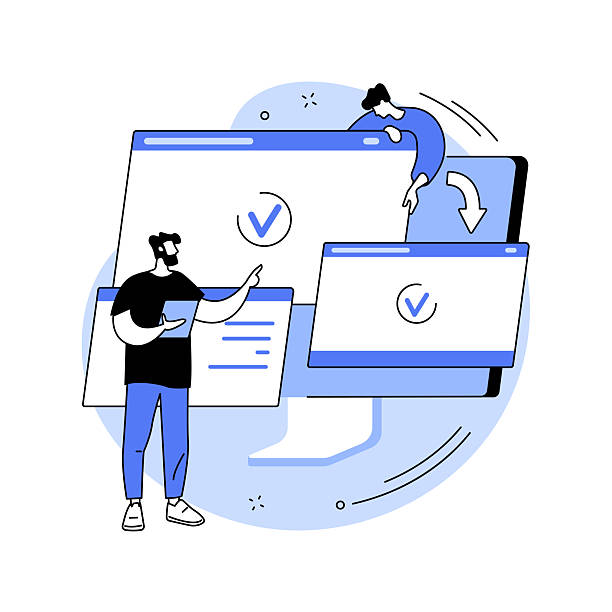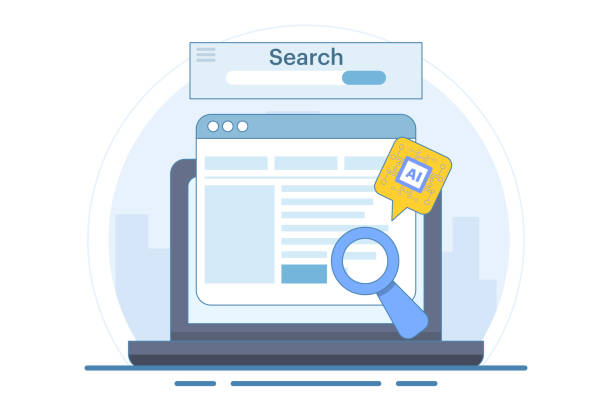Why is now the right time to design an e-commerce website?
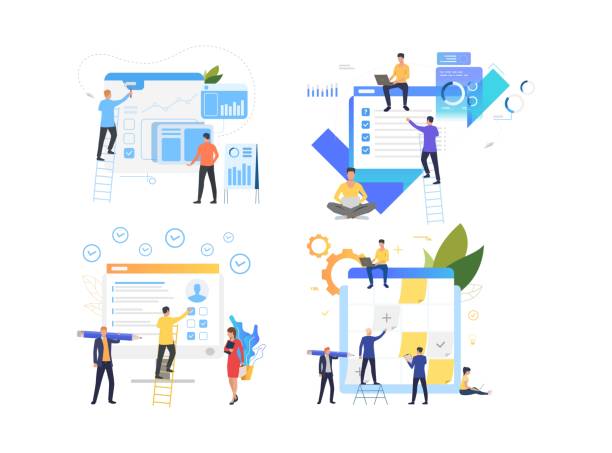
In today’s world, the importance of #e-commerce and the online presence of businesses can no longer be ignored.
Designing an e-commerce website is not just an option; it’s a vital necessity for survival and growth in the current competitive market.
This platform allows you to introduce your products or services to a wider range of audiences worldwide, without the spatial and temporal limitations of a physical store.
With the ever-increasing number of internet users and their preference for online shopping, investing in creating an online store is not only logical but also highly profitable.
This marks a paradigm shift from traditional businesses towards modern #online_sales models.
One of the main advantages of e-commerce is the significant reduction in overhead costs.
You no longer need to rent expensive premises, hire a large sales staff, or pay heavy utility bills.
An e-commerce website is ready to serve your customers 24/7, without requiring a physical presence.
This provides an unparalleled opportunity, especially for small and medium-sized businesses, to compete with market giants.
Furthermore, access to customer data and the analysis of their behavior enable personalized services and continuous improvement of user experience.
This data-driven approach facilitates the optimization of marketing and sales strategies.
Understanding these basic concepts is essential for anyone considering #launching_an_online_store.
In the following, we will delve into more details about the stages and challenges of e-commerce website design to guide you through this complex and challenging path.
Did you know that poor online store design can drive away up to 70% of your potential customers? Rasaweb transforms your sales with professional and user-friendly e-commerce website design.
✅ Significant increase in sales and revenue
✅ Full optimization for search engines and mobile devices
⚡ [Get free consultation from Rasaweb]
Key Advantages of a Successful E-commerce Website

A well-designed #online_store brings numerous benefits to businesses that go beyond merely selling products.
The most significant advantage is #global_reach.
Your business is no longer limited to a specific geographical area and can reach customers anywhere in the world.
This means potential increases in sales and market growth.
Furthermore, an e-commerce website allows for 24/7 operation.
This constant accessibility enables customers to shop whenever it suits them, significantly increasing conversion rates.
This is one of the most vital reasons for e-commerce website design.
Another advantage is #cost_reduction.
Setting up and maintaining an online store is significantly cheaper than a physical store.
Costs for rent, utilities, human resources, and physical maintenance are reduced or eliminated.
These savings can be reinvested into other areas of the business, such as marketing or product development.
Also, an #e-commerce_website allows you to collect and analyze precise customer data.
This data includes information about visitors, preferred products, purchase history, and behavioral patterns.
These insights are invaluable for personalizing the shopping experience, improving marketing strategies, and optimizing inventory.
Digital marketing through SEO, paid advertising, and social media is also easily executable via an online platform.
With e-commerce website design, you will have complete control over your brand and how it is presented to customers.
This flexibility in branding and marketing allows you to create a unique image for your business, which is crucial in today’s crowded market and sets you apart from competitors.
Essential Components in Designing an Efficient E-commerce Website
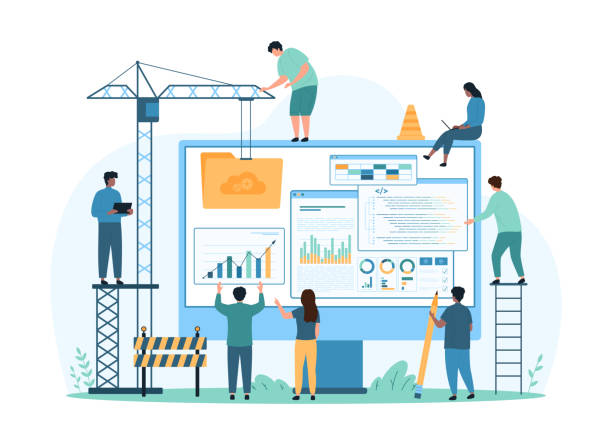
Successful #e-commerce_website_design requires attention to several key components that improve User Experience (UX) and help increase conversion rates.
One of the most important components is #responsive_design.
Your website must display well and function properly on all devices, from desktops to tablets and mobile phones.
Given the increase in mobile shopping, this feature is absolutely vital, and its absence can lead to the loss of a significant portion of customers.
The next point is #simple_and_intuitive_navigation.
Customers should be able to easily find their desired products, browse through categories, and reach the shopping cart and checkout process.
This includes clear menus, powerful search functionality, and appropriate filters that reduce the time spent searching for products.
An easy purchasing process and minimal checkout steps are also highly important.
The more complex the payment process, the higher the likelihood of cart abandonment, which means lost sales.
Offering diverse and secure payment options, such as reputable banking gateways, credit cards, and even cash-on-delivery (if applicable), builds customer trust.
Website loading speed is also a critical factor.
Users expect pages to load quickly; any delay can result in customer loss.
Optimizing images, using caching, and choosing a powerful hosting provider can help with this.
Below, some of the most important components are mentioned:
| Component | Importance | Key Example |
|---|---|---|
| Responsive Design | Compatibility with all devices for increased accessibility | Correct display of the website on mobile, tablet, and desktop |
| Intuitive and Simple Navigation | Easy and quick access to products and sections | Clear category menus, advanced search functionality |
| High Loading Speed | Retaining users and improving search engine ranking | Page loading in less than 3 seconds |
| Simple and Secure Payment Process | Reducing cart abandonment rate and increasing trust | Minimum steps for payment, diverse payment options |
Additionally, high-quality content, including high-resolution product images, complete and accurate descriptions, and customer reviews, plays a significant role in purchasing decisions and helps customers make more informed choices.
These factors directly impact user experience and, ultimately, the success of your e-commerce website design, potentially making the difference between an average store and an outstanding one.
Choosing the Right Platform for Your Online Store Design
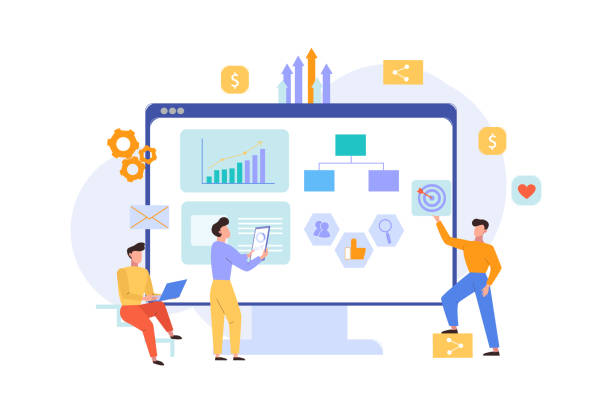
One of the most important decisions in #e-commerce_website_design is choosing the #right_platform.
Numerous options are available, each with its own advantages and disadvantages, and they can vary depending on your needs and budget.
#Open_Source platforms like WooCommerce for WordPress, #PrestaShop, and #Magento are powerful and flexible options.
WooCommerce is very popular due to its integration with WordPress and is highly suitable for small and medium-sized businesses, providing many features without the need for coding.
Magento is designed for large and complex stores with high customization needs and offers excellent scalability, while PrestaShop provides a balance between the two and is suitable for a wide range of businesses.
These platforms, due to their access to source code, allow for deep customizations but require more technical knowledge for setup and maintenance.
In contrast, #SaaS (Software as a Service) platforms like Shopify, Wix, and BigCommerce offer ready-made and user-friendly solutions.
These platforms do not require programming knowledge and provide all necessary features, including hosting, security, updates, and support, for a monthly or annual fee.
Shopify is especially an excellent option for those looking to quickly and easily launch an online store and has a vast ecosystem of apps and themes.
The choice between these two types of platforms depends on factors such as budget, technical skill level, required scalability, and the degree of control over the code.
If you are looking for e-commerce website design with high development and customization capabilities and have a technical team, open-source options are better; but if you prefer speed and ease, SaaS is a more suitable choice.
Ultimately, thorough research and consultation with experts before choosing a platform for #building_a_sales_website are crucial to ensure you select the platform that best aligns with your business goals.
Are you worried your old company website is driving away new customers? Rasaweb solves this problem with modern and efficient corporate website design.
✅ Increases your brand credibility.
✅ Helps attract targeted customers.
⚡ Contact Rasaweb for a free consultation!
The Importance of User Experience (UX) and User Interface (UI) in E-commerce Website Design

When #designing_an_e-commerce_website, two concepts, #User_Experience (UX) and #User_Interface (UI), play pivotal roles.
These two work together to ensure a website is not only beautiful but also functional and effective.
#UI refers to the look and feel of the website: colors, fonts, layout of buttons and forms, and generally everything the user sees and interacts with.
An attractive and professional user interface is the first step to gaining customer attention and trust, and it gives your website an identity.
But beauty alone is not enough; this is where #UX comes in.
#UX deals with how the user interacts with the site and what feelings they experience during this interaction.
Is it easy to find a product? Is the payment process smooth? Is information clearly presented? The ultimate goal of UX design in an online store is to create a seamless and enjoyable shopping journey for the user.
This includes designing logical navigation paths, reducing the number of clicks to reach a goal, providing friendly and guiding error messages, and ensuring the site’s compatibility with all devices (responsiveness).
Also, #user_feedback and #testability are critical elements in improving UX.
Conducting A/B tests on different layouts, color schemes, and payment processes, and collecting customer feedback can help you identify weaknesses and address them, continuously improving the user experience.
Remember that an #e-commerce_website with poor UX and UI, even if it has the best products, will struggle to attract and retain customers, and its cart abandonment rate will be high.
Investing in professional UX/UI design for your e-commerce website is, in fact, an investment in your business’s long-term success and will make customers return to your store.
The difference between UX and UI is very important, and understanding it helps improve #e-commerce_website_design.
This deep understanding allows you to create a platform that not only meets your business needs but also provides an unforgettable experience for your customers.
Digital Marketing and SEO Strategies to Increase E-commerce Website Traffic
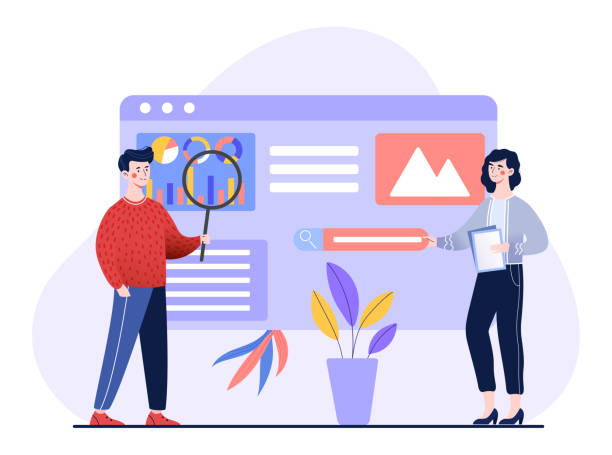
After completing #e-commerce_website_design, the next step is customer acquisition.
This is where #digital_marketing and #Search_Engine_Optimization (SEO) come into play.
Without a strong marketing strategy, even the best online store might go unnoticed and drown in the ocean of websites.
#SEO is the process of improving your website’s ranking in organic search results on Google and other search engines.
This includes keyword research related to your products and services, content optimization (writing SEO-friendly product descriptions and valuable blog articles), technical site optimization (such as loading speed, proper URL structure, and XML sitemaps), and building quality backlinks.
Strong #SEO ensures that potential customers can easily find you, and targeted traffic flows to your e-commerce website, which means an increased chance of sales.
In addition to SEO, there are other strategies to increase traffic to your #e-commerce_website.
#Content_marketing involves creating blogs, articles, videos, and guides related to your products, which adds value for customers and also helps with SEO.
This content can answer common customer questions and guide them towards a purchase.
#Social_Media_Marketing allows you to interact with your audience, build your brand, and promote your products.
Using platforms like Instagram, Telegram, and Twitter for publishing engaging content and running advertising campaigns is highly effective.
#Pay-Per-Click (PPC) advertising, such as Google Ads, is also a quick way to attract targeted traffic, although it requires a budget.
These ads allow you to appear at the top of search results and immediately reach customers.
Email marketing is also a powerful tool for retaining customers and encouraging repeat purchases.
Sending newsletters, discounts, and special offers can strengthen your relationship with customers.
Combining these strategies is essential for e-commerce website design and its success, helping you grow sustainably.
For more information on SEO, you can refer to reliable resources and increase your knowledge in this field.
Security and Payment Gateways in Online Store Design
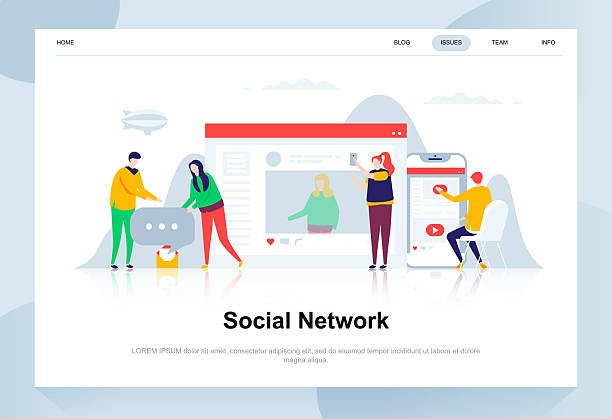
One of the most sensitive aspects in e-commerce website design is ensuring the #security_of_customer_information and financial transactions.
Any security breach can lead to a loss of customer trust and severe damage to your brand’s reputation, and even have legal consequences.
Using an #SSL_certificate (Secure Socket Layer) is a fundamental step that provides a secure connection between the user’s browser and your website server.
This certificate encrypts sensitive data such as banking card information and prevents unauthorized access.
You can ensure the presence of SSL by observing the green padlock icon next to the website address in the browser.
This is a visual sign for customers, assuring them that their information is safe.
Alongside SSL, choosing a #secure_and_reputable_payment_gateway is also crucial.
In Iran, Shaparak payment gateways (under the supervision of the Central Bank) like ZarinPal, IDPay, and Mellat-Pardakht are common options.
These gateways manage the payment process securely and in accordance with banking standards, using the latest security protocols to protect users’ financial data.
The importance of a reliable payment gateway for an #online_store is such that its absence can lead to lost sales and customer distrust.
Furthermore, implementing other security protocols such as #Firewall to prevent network attacks, #regular_data_backups for quick recovery in case of issues, and continuous updates of software and plugins are among the essential measures for maintaining the security of your e-commerce website.
Below, some important security aspects are listed:
| Security Aspect | Importance | Required Action |
|---|---|---|
| SSL Certificate | Data encryption, building trust, and SEO improvement | Installation and regular renewal of SSL (HTTPS) |
| Secure Payment Gateway | Protection of financial information and transactions | Using reputable and approved gateways (e.g., Shaparak) |
| Regular Backups | Quick data recovery in case of a serious issue | Scheduling daily or weekly backups |
| Software Updates | Fixing security vulnerabilities and improving performance | Installing the latest versions of CMS, themes, and plugins |
Given the increasing growth of cyber threats, #building_a_sales_website with a strong security infrastructure is a necessity.
Awareness of the latest payment gateway security standards and their implementation helps you create a reliable online sales platform and put your customers’ minds at ease regarding the protection of their information.
Maintenance and Support for the E-commerce Website After Launch
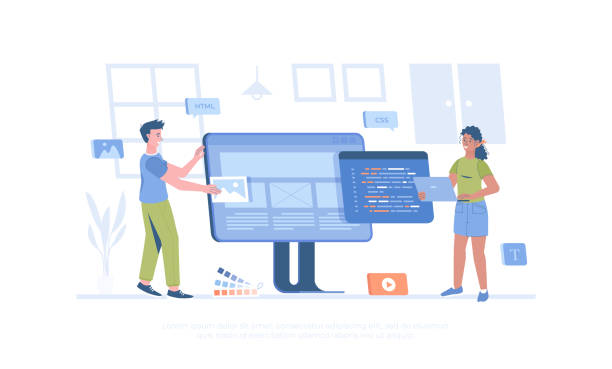
E-commerce website design is only the beginning.
To ensure the smooth operation and long-term success of your online store, #continuous_maintenance_and_support are extremely vital.
A static website will gradually lose its effectiveness and may face security issues, slow speeds, or incompatibility with new technologies, all of which harm user experience and ultimately your sales.
The first step in maintenance is #regular_updates of the Content Management System (CMS), themes, and plugins.
Developers constantly release new versions that include bug fixes, performance improvements, and security patches.
Failure to update can leave your site vulnerable to cyber-attacks and gradually decrease its performance.
In addition to updates, #regular_backups of all website data and files are essential.
In case of any technical issue, cyber-attack, or human error, having fresh backups allows you to quickly restore the site and prevent the loss of important customer information and sales.
#Website_performance_monitoring is also of high importance.
Using tools like Google Analytics to track traffic, bounce rate, page loading times, and user behavior allows you to identify weaknesses and take action to improve them.
This data provides valuable insights for continuous optimization.
#Continuous_website_speed_optimization, through image compression, use of CDN (Content Delivery Network), and website code optimization, improves user experience and helps with SEO.
Technical support, whether internal or through specialized companies, is essential for resolving unforeseen issues and providing necessary guidance.
Ensuring #quick_response to customer inquiries and resolving their problems is also a crucial part of after-sales support that significantly helps maintain customer satisfaction.
Finally, #data_analysis and performing A/B tests to continuously improve product pages, checkout processes, and special offers contribute to the continuous growth of your e-commerce website.
A regular maintenance plan for your e-commerce website design ensures sustained success and preserves and increases your investment over time.
Did you know that poor online store design can drive away up to 70% of your potential customers? Rasaweb transforms your sales with professional and user-friendly e-commerce website design.
✅ Significant increase in sales and revenue
✅ Full optimization for search engines and mobile devices
⚡ [Get free consultation from Rasaweb]
The Future of E-commerce Website Design: New Trends and Challenges

The #future_of_e-commerce, and consequently e-commerce website design, is evolving at a breakneck pace.
Will online stores soon become something more than just a simple website? The answer is most likely yes.
One significant trend is #Artificial_Intelligence (AI) and #Machine_Learning (ML).
These technologies help #online_stores heavily personalize the shopping experience.
From product recommendations based on purchase and browsing history to smart chatbots that answer customer questions and even help them find products, AI will play a key role, ensuring each user has a unique experience.
Are we ready for robots to assist us in shopping and influence our decisions?
Another trend is #Augmented_Reality (AR) and #Virtual_Reality (VR).
Imagine being able to virtually try on clothes before buying them, or view furniture in your own home space.
These technologies can elevate the online shopping experience to a whole new level and bridge the gap between online and physical shopping.
Furthermore, #Voice_Commerce, using voice assistants like Siri and Alexa, is on the rise.
E-commerce website design in the future must also be optimized for these types of interactions and be able to respond to users’ voice commands.
#Web3 and #Blockchain may also play a significant role in security, transparency, and digital ownership in the future, enabling new models of e-commerce.
However, these trends also come with challenges.
How will #data_privacy be maintained in an era of widespread AI and data mining? Are consumers ready to accept this level of personalization and allow businesses access to their data? How should #cybersecurity be enhanced with increasing technological complexity to prevent potential misuse? Increasing competition and market saturation also mean that future e-commerce websites must not only perform flawlessly but also offer a unique story and differentiate themselves from competitors.
Can businesses keep pace with this speed of transformation and prepare themselves for this future? The answers to these questions will determine the path of the future of e-commerce and require strategic thinking and high flexibility.
Practical Steps to Start Designing Your E-commerce Website

If you are now convinced that e-commerce website design is essential for your business, it’s time to move on to practical steps.
The first step is #comprehensive_planning.
Before doing anything, define your needs.
What products will you sell? Who are your target customers and how do you want to reach them? What specific features do you need (such as an online booking system, product customization capability, or a rating and customer review system)? What is your budget and how much time have you allocated for launch? This detailed planning will help you make better choices regarding the platform and design approach, and prevent waste of time and resources.
The next step is #choosing_a_domain_and_hosting.
Your domain name (your website’s address) should be short, memorable, and relevant to your business to easily stick in customers’ minds.
Hosting is the infrastructure on which your site resides and must have high speed and security to provide a suitable user experience.
Then, it’s time to #choose_the_right_platform, which we discussed in detail in previous sections; this choice should be made based on your needs and technical capabilities.
After platform selection, the #design_and_development phase begins.
This includes installing and configuring the platform, selecting and customizing a suitable theme, designing the user interface and user experience, and customizing features.
If you lack sufficient technical knowledge, it’s advisable to seek help from a #specialized_website_design_team to create a professional e-commerce website for you.
Adding products and content is also a key stage.
High-quality images, accurate and engaging product descriptions, appropriate pricing, and shipping and return information are all essential for attracting and convincing customers and help increase conversion rates.
Finally, after thorough testing and ensuring all sections function correctly, #website_launch and #marketing begin.
Remember that e-commerce website design is an ongoing process, and even after launch, it requires updates, optimization, and marketing to remain successful in today’s competitive market.
By taking these steps and focusing on providing an #excellent_user_experience, you can launch a successful and profitable online store and elevate your business to a new level.
The online store setup guide can be a useful resource to assist you through all stages.
Frequently Asked Questions
| Row | Question | Answer |
|---|---|---|
| 1 | What is an e-commerce website? | It’s a website that allows for the online buying and selling of products or services, enabling users to view, select, and purchase items. |
| 2 | Why do we need e-commerce website design? | With an e-commerce website, businesses can reach a wider audience, operate 24/7, reduce operational costs, and increase their sales. |
| 3 | What are the main features of a successful e-commerce website? | Product catalog, shopping cart, secure payment gateway, order management system, user panel, product search and filter capabilities, and responsive design. |
| 4 | What are the common platforms for e-commerce website design? | Common platforms include WordPress (with WooCommerce plugin), Shopify, Magento, PrestaShop, or custom development (coding from scratch). |
| 5 | What is the importance of User Interface (UI) and User Experience (UX) in e-commerce website design? | Proper UI/UX design leads to improved customer experience, reduced bounce rate, increased user time on site, and ultimately increased conversion rates and sales. |
| 6 | What are the key stages of designing an e-commerce website? | These stages include planning and research, aesthetic and UI design, technical development and coding, content entry, testing and debugging, launch, and support. |
| 7 | What is the importance of security in e-commerce websites? | Security is crucial for protecting sensitive user information (like payment and personal data) and gaining customer trust. Using SSL certificates and secure payment gateways is essential. |
| 8 | What does SEO mean for an e-commerce website? | It means optimizing the website for search engines like Google so that product pages and categories appear higher in search results and attract more organic (free) traffic. |
| 9 | What is the role of payment gateways in an e-commerce website? | A payment gateway is the bridge between the customer and the bank, enabling secure and online financial transactions and transferring money from the customer’s account to the seller’s account. |
| 10 | What does Responsive Design mean in an e-commerce website? | It means that the e-commerce website should display correctly and be easy to use on any device (mobile, tablet, laptop) without losing information or having a disrupted layout. |
And other services of Rasaweb Advertising Agency in the field of advertising
Smart UI/UX: Designed for businesses looking to increase website traffic through precise audience targeting.
Smart Google Ads: Designed for businesses looking to increase click-through rates by optimizing key pages.
Smart Website Development: An innovative service to enhance campaign management through user experience customization.
Smart Marketplace: A professional solution for campaign management focusing on precise audience targeting.
Smart Link Building: Professional optimization for customer acquisition using key page optimization.
And over hundreds of other services in the field of internet advertising, advertising consultation, and organizational solutions
Internet Advertising | Advertising Strategy | Advertorial
Resources
Google Search EnginePersian WikipediaAparat Video Sharing ServiceIslamic Republic News Agency (IRNA)
💡 Rasaweb Afarin Digital Marketing Agency, your strategic partner on the path to online brilliance! With services such as professional SEO, social media management, and multilingual website design, we guarantee a powerful and impactful online presence for your business. Contact us today and build your business’s digital future.
📍 Tehran, Mirdamad Street, next to Central Bank, Southern Kazeroun Alley, Ramin Alley, No. 6

